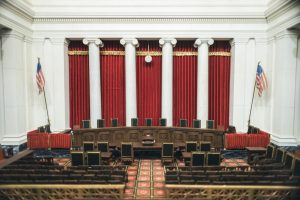“Terms of Service.” Probably all of us have been asked at some point or another to agree to a company’s TOS in order to access its services. Most often, this happens when we download an app to our phone, though it can happen on a regular website as well. It’s not like we have much choice: if we want to use the app, we must agree to the TOS. If we don’t want to agree, we can’t use the app. In practice, that almost always means we agree to the TOS.
TOS commonly contain an arbitration clause. Depending on the clause, arbitration may be subject to—for example—restrictions on remedies, prohibitions against class actions, or limits on recoverable damages. And under typical arbitration rules, there will almost certainly be less and narrower discovery than in court. So it should come as no surprise that some lawyers and litigants cast about for ways to get around arbitration clauses, including in cases where the clause is in TOS.
Last month, in Davitashvili v. Grubhub, No. 23-521 (2d Cir. Mar. 13, 2025), the Second Circuit addressed almost every conceivable threshold question about whether a dispute is arbitrable. In that case, the court looked at three different companies’ TOS to assess (1) whether the parties had agreed to arbitrate at all; (2) if they had agreed to arbitrate, whether it was a court or arbitrators who should decide whether the dispute was within the arbitration clause; (3) if it was for the court to decide, whether the dispute was within the arbitration clause; and (4) if the dispute was covered by the clause, whether the clause was enforceable. In other words, this case presented pretty much every arbitrability-related threshold question imaginable.
Here are the facts. Grubhub, Postmates, and Uber all provide online platforms where customers can order meals from restaurants for pickup and delivery. The restaurants agreed with the platforms not to sell their meals at prices lower than they charge on the platform. That agreement was the basis for an antitrust class action. Three purported classes of restaurant customers sued: those who bought food for delivery or takeout at the restaurants but not on the platforms; those who dined in the restaurants; and those who bought from these restaurants on some other platform. The idea was that, because the platforms required the restaurants not to sell at prices lower than on the platforms, each of these classes had to pay higher prices for their meals than they would have otherwise. In other words, the class action alleged a form of price-fixing.
Note that these classes aren’t defined by reference to any of the platforms’ apps—obviously in order to get around the arbitration clauses in each app’s TOS. But some of the class members (maybe many, or even most) had actually downloaded one or more of the platforms’ apps and accepted their TOS. So does that mean they have to arbitrate their claims?
The first issue was whether there was an agreement to arbitrate at all. There was no issue when it came to Uber and Postmates—those platforms’ customers had agreed to arbitrate. For Grubhub it was less clear. The issue was whether the screen on Grubhub’s interface was designed so that users had inquiry notice of the TOS they were being asked to accept. Typically, for “click-wrap” agreements, in which users are asked to agree to TOS, the users are bound only if they had at least “inquiry” notice of the TOS. Whether there was inquiry notice turns, broadly speaking, on whether the interface makes clear to a user that the “agree” (or “confirm”) button links to the TOS, without excessive distraction on the page, and whether the TOS are reasonably accessible.
In this case the Second Circuit held that the Grubhub web interface was clean and clear enough to place a reasonably prudent user on inquiry notice—though Judge Pérez in her concurring opinion thought Grubhub made the cut just barely, commenting that if the “interface were even marginally more cluttered, the outcome of this appeal would likely be different.” So companies asking users to agree to their TOS would be well-advised to make sure that the screen presenting the TOS to users for agreement should be clean, uncluttered and clear.
Because Grubhub users were on inquiry notice there was an agreement to arbitrate. That led to the next issue: who should decide whether that agreement to arbitrate covers the price-fixing dispute—should it be a court or an arbitrator? This question turns on the language of the arbitration clause. Under Grubhub’s TOS, “issues related to the scope, validity, and enforceability of this Arbitration Agreement are for a court to decide.” So that was pretty clear. But the outcome was different for Uber and Postmates—the Second Circuit held that arbitrators rather than a court decide whether the arbitration clauses in their TOS cover the dispute.
The main remaining issue as to Grubhub was this: were the antitrust class action claims covered by the arbitration clause? The Second Circuit’s answer was no. The key issue was whether the language of the arbitration clause covered the antitrust class actions. Here is the relevant part of Grubhub’s TOS:
You and Grubhub agree that all claims, disputes, or disagreements that may arise out of the interpretation or performance of this Agreement or payments by or to Grubhub, or that in any way relate to your use of the Platform, the Materials, the Services, and/or other content on the Platform, your relationship with Grubhub, or any other dispute with Grubhub, (whether based in contract, tort, statute, fraud, misrepresentation, or any other legal theory) (each, a ‘Dispute’) shall be submitted exclusively to binding arbitration.
Recall the basis of the antitrust claims: the plaintiffs alleged that Grubhub essentially fixed prices by requiring restaurants that sold through Grubhub to agree not to charge lower prices elsewhere than they charge on Grubhub. Grubhub argued that the antitrust claims “relate to [the plaintiffs’] use of the Platform” because their use of Grubhub’s services helped give Grubhub the economic clout to engage in the claimed anticompetitive activity. But the Second Circuit viewed that as too speculative and tenuous a connection to the claims. In the court’s view, the antitrust claims arose from the plaintiffs’ use of other platforms or direct dealings with the restaurants, where they had to pay allegedly artificially high prices, and not from their use of Grubhub’s app. In fact, some class members had never even accessed the Grubhub app—which underscored the court’s point that it was just a coincidence that some members of the plaintiff classes had used Grubhub’s platform.[1]
The bottom line is that the antitrust class actions against Grubhub remained in court. But that is not the end of matters. There are two additional opinions: one concurrence and one partial dissent. They are worth noting because they may presage issues that might come up in the future.
First, Judge Pérez’s concurrence. Judge Pérez stressed that the under the Federal Arbitration Act (“FAA”), a court can compel arbitration only if the dispute arises out of the particular contract that contains the arbitration clause—in her words, if there is a “nexus” between the claim and the contract. In other words, it doesn’t matter how broadly drafted the clause may be; Judge Pérez would say that a court does not have power to direct the parties to arbitration if a particular dispute doesn’t clearly enough “aris[e] out of” the contract (in the words of the FAA). Depending on how narrowly a future court may view any proposed “nexus,” this approach may materially alter the scope of courts’ perceived authority to send disputes to arbitration.
Judge Sullivan dissented in part. He agreed there must be some kind of connection (or nexus) between the dispute and the contract containing the arbitration clause, so a dispute that is completely unrelated to the contract cannot be sent to arbitration. But his view of an adequate connection was different from the other judges on the panel. He thought the class action claims did arise from the apps. The plaintiffs’ theory of liability was that Grubhub through its app had amassed so much market power that restaurants had no choice but to agree to Grubhub’s “no price competition” terms. Thus, reasoned Judge Sullivan, if pervasive use of Grubhub is the basis for the antitrust claims, the claims “arise out of” use of Grubhub for purposes of compelling arbitration under the FAA.
Where does this leave us? It isn’t every day that we get three opinions from a three-person appellate panel. Is this case a harbinger of a possibly less broad policy in favor of arbitration at the federal level? Might it indicate ongoing ferment about how tight the connection has to be between claims and clause before a dispute can be referable to arbitration? It remains to be seen. Ultimately, of course, the final say on the matter will be with the Supreme Court.
The plaintiffs had also argued that it would be unconscionable to require their claims to be arbitrated, but the Second Circuit was unimpressed. The plaintiffs had not even sufficiently advanced the argument in their papers, and certainly not in enough detail to be considered properly. ↑












